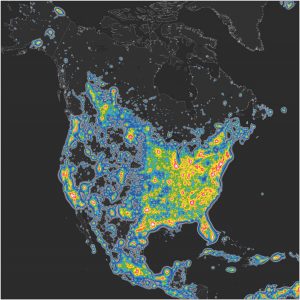Is light pollution high on your list of concerns? With so many disturbing developments happening globally, light pollution probably doesn’t hold a candle to your worries about accelerating climate change, failing governments, or spreading superbugs.
Nevertheless, we are learning more about the impacts of light pollution and there are people in many fields including ecology, astronomy, health care, and land-use planning who are concerned about it. A study published last year quantified and mapped the amount of light pollution across the world. Unsurprisingly, North America and especially the east coast are completely saturated with it.

Why would a regular person care about light pollution?
Light pollution spreads gradually (one outdoor light can impact darkness up to 15 feet away) so the elders among us probably forget what they used to be able to see during clear nights: the milky way, comets, millions of additional stars – in other words – spectacular nighttime vistas.
Since light pollution is a new phenomenon evolutionarily speaking, the health consequences to humans are poorly understood. Some studies are pointing to links between light pollution and chronic sleep loss, certain cancers, obesity, and mood disorders.
Besides humans, light pollution interferes with wildlife, with obvious implications to their migrations and circadian rhythms. We’ll likely find out more ways our light is confusing animals who evolved without it for thousands of years.
Connecticut has a few regulations in place to control impacts of light pollution from state-owned buildings and roads, but looking at the map above, this isn’t doing enough. Like so much else, it will take action at the local level to return millions of missing stars to our sky.